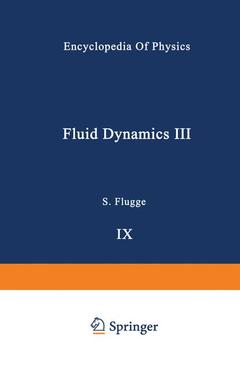Fluid Dynamics / Strömungsmechanik, Softcover reprint of the original 1st ed. 1960 Coll. Mechanisches und thermisches Verhalten der Materie / Mechanical and Thermal Behaviour of Matter
Langue : Français
Coordonnateur : Truesdell C.A.

Sect 2. 317 tinuity surfaces 1. This suggests that a wake pressure Pw be associated with each flow past a bluff body, and that a wake parameter (2. 4) which plays the same role as the cavitation parameter (2. 1), be defined for the flow. This idea has been made the basis of a modified wake theory (ef. Sect. 11) which proves to be in good qu- titative agreement with pressure and drag measurements. It should be emphasized, however, that un h like the cavitation number, the wake parameter is a quantity which is not known a priori, and must be empirically determined in each case. (3) Jet flows. The problem of jet efflux from an orifice is one of the oldest in hydrodynamics and the first to be treated by Fig. 3a. the HELMHOLTZ free streamline theory. Of particular importance for engineering applications is the discharge coefficient Cd' which is defined in terms of the discharge Q per unit time, the pressure P, and the cross-sectional area A of the orifice, by the formula, (2. 5) where e is the fluid density. Two methods of measuring Cd have been most fre quently adopted. In the first the liquid issues from an orifice in a large vessel under the influence of gravity _,-____________ . , (Fig. 3 a), while in the second it 1 L is forced out of a nozzle or pipe under high pressure (Fig. 3 b).
Analytical Theory of Subsonic and Supersonic Flows.- I. Physical and mathematical foundations.- II. Linearized theory.- III. The hodograph method.- IV. The analytical theory of two-dimensional subsonic flows.- V. The analytical theory of two-dimensional transonic flows.- General references and textbooks.- Théorie des ondes de choc.- A. Les équations des phénomènes de choc.- a) Introduction.- b) Démonstration des équations des phénomènes de choc.- c) Chocs stationnaires dans les écoulements uniformes.- B. Les ondes de choc dans les écoulements stationnaires.- I. La formation des ondes de choc.- II. Les ondes de choc détachées.- III. Les ondes de choc attachées dans les écoulements plans.- a) Etude des chocs uniformes.- b) Ecoulement autour d’un obstacle terminé par un dièdre.- c) Ecoulement autour d’une ogive.- IV. Les ondes de choc attachées dans les écoulements à trois dimensions.- a) Ecoulements coniques de révolution.- b) Ecoulements de révolution.- c) Ecoulements coniques.- C. Les ondes de choc dans les écoulements non stationnaires.- I. Formation et propagation des ondes de choc planes.- a) Etude des chocs uniformes.- b) Exemples de chocs non uniformes.- c) La formation des chocs dans les tuyères.- II. Rencontre d’une onde de choc plane et d’un dièdre.- a) Cas de la réflexion régulière.- b) Cas de la réflexion de Mach.- c) Etude de l’écoulement après le choc.- III. Etude des ondes de choc sphériques.- IV. Etude des translations rectilignes de vitesse variable.- Annexe. Propagation des chocs dans les gaz ionisés.- Bibliographie.- Theory of Characteristics of Inviscid Gas Dynamics.- A. Introduction.- B. One-dimensional unsteady motion.- I. Homentropic motion.- a) Characteristic equations and simple waves.- b) Structure of the motion.- c) Solution of the general wave-interaction problem.- II. Motion with entropy variation.- C. Steady two-dimensional supersonic flow.- I. Homentropic irrotational flow.- a) Characteristic equations and simple waves.- b) Structure of the flow.- c) Analytical solution methods.- II. Flow with entropy variation.- D. Steady axially symmetrical supersonic flow.- References.- Linearized Theory of Unsteady Flow of a Compressible Fluid.- I. Formulation of the problem.- II. Explicit solutions.- a) Subsonic case.- b) Applications.- III. The method of integral equations.- IV. Reciprocity relations.- References.- Jets and Cavities.- I. Physical and mathematical foundations.- II. Particular flows.- a) The hodograph method.- b) The method of reflection.- c) Inverse and semi-inverse solutions.- d) Approximate theories.- III. Qualitative theory.- a) Geometric properties of free streamlines.- b) Comparison methods.- c) Variational principles.- IV. Existence and uniqueness theory.- a) Existence theory.- b) Uniqueness theory.- V. Numerical methods.- a) Plane flows past curved obstacles.- b) Axially symmetric flows.- General references.- Surface Waves.- A. Introduction.- B. Mathematical formulation.- 1. Coordinate systems and conventions.- 2. Equations of motion.- 3. Boundary conditions at an interface.- 4. Boundary conditions on rigid surfaces.- 5. Other types of boundary surfaces.- C. Preliminary remarks and developments.- 6. Classification of problems.- 7. Progressive waves and wave velocity—standing waves.- 8. Energy.- 9. Momentum.- 10. Expansion of solutions in powers of a parameter.- D. Theory of infinitesimal waves.- 11. The fundamental equations.- 12. Other boundary conditions.- 13. Some mathematical solutions.- 14. Some simple physical solutions.- 15. Group velocity and the propagation of disturbances and of energy.- 16. The solution of special boundary problems.- 17. Two-dimensional progressive and standing waves in unbounded regions with fixed boundaries.- 18. Three-dimensional progressive and standing waves in unbounded regions with fixed boundaries.- 19. Problems with steadily oscillating boundaries.- 20. Motions which may be treated as steady flows.- 21. Waves resulting from pressure distributions.- 22. Initial-value problems.- 23. Waves in basins of bounded extent.- 24. Gravity waves in the presence of surface tension.- 25. Waves in a viscous fluid.- 26. Stability of free surfaces and interfaces.- 27. Higher-order theory of infinitesimal waves.- E. Shallow-water waves.- 28. The fundamental equations for the first approximation.- 29. The linearized shallow-water theory.- 30. Nonlinear shallow-water theory.- 31. Higher-order theories and the solitary and cnoidal waves.- F. Exact solutions.- 32. Some general theorems.- 33. Waves of maximum amplitude.- 34. Explicit solutions.- 35. Existence theorems.- G. Bibliography.- Sachverzeichnis (Deutsch-Englisch).- Subject Index (English-German).- Table des matières (Français).
Date de parution : 03-2012
Ouvrage de 816 p.
17x24.4 cm
Disponible chez l'éditeur (délai d'approvisionnement : 15 jours).
Prix indicatif 105,49 €
Ajouter au panierThème de Fluid Dynamics / Strömungsmechanik :
Mots-clés :
Strömung; Strömungsmechanik; dynamics; fluid dynamics; mechanics; fluid- and aerodynamics
© 2024 LAVOISIER S.A.S.



